
Lake Waikareiti, also spelt Lake Waikare Iti, is located in Te Urewera National Park in the North Island of New Zealand. A number of hiking trails are found within the catchment basin of the lake.

Pomona Island is the largest island within Lake Manapouri, in Fiordland National Park, in New Zealand's South Island. With an area of 262 hectares, it is the largest island to be found within any New Zealand lake.

Nothofagus truncata, or hard beech, is a species of tree endemic to New Zealand. Its common name derives from the fact that the timber has a high silica content, making it tough and difficult to saw. Hard beech is a tree up to 30m tall occurring in lowland and lower montane forest from latitude 35°S to 42°30'S, that is, from the north of the North Island southwards to Marlborough and south Westland in the South Island. In Taranaki it forms almost pure stands on the rugged sandstone country there and is partially deciduous, dropping many of its leaves at the end of the winter. N. truncata became known as Fuscospora truncata after 2013 in New Zealand.

Cranfillia fluviatilis, synonym Blechnum fluviatile, is a fern known in the Māori language as kiwikiwi. A herbaceous plant, C. fluviatilis is a "hard fern" of the genus Cranfillia in the family Blechnaceae. It was identified by Patrick Brownsey in 1979. Other common names are star fern, creek fern, kawakawa and kiwakiwa.

Tmesipteris tannensis is a fern ally endemic to New Zealand. It is usually epiphytic on trees and tree ferns, but is occasionally terrestrial.
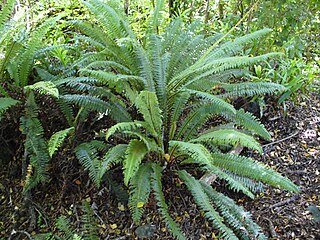
Lomaria discolor, synonym Blechnum discolor, commonly called crown fern, is a species of fern in the family Blechnaceae. This species is endemic to New Zealand. As noted by C. Michael Hogan, this species is found in a number of forest communities in diverse locations within New Zealand, and is sometimes a dominant understory component.

Zealandia pustulata, synonym Microsorum pustulatum, is a species of fern within the family Polypodiaceae.

Dendroconche scandens, synonym Microsorum scandens, commonly called fragrant fern, is a species of fern within the family Polypodiaceae. This species is native to parts of New Zealand and Australia, as well as some offshore islands. It has been introduced to South Africa and Zimbabwe. An example occurrence in New Zealand's North Island is in the Hamilton Ecological District where it is associated with a number of other ferns including Icarus filiforme and Lomaria discolor.

Asplenium flaccidum is a species of fern in the family Aspleniaceae. The plant common name is drooping spleenwort or weeping spleenwort, and the species name flaccidum derives from the Latin root meaning drooping. An example occurrence of A. flaccidum is within a Nothofagus-Podocarp forest at Hamilton Ecological District on New Zealand's North Island in association with other fern species understory plants, crown fern, Blechnum discolor being an example.
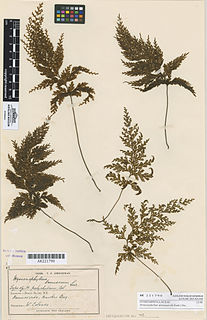
Hymenophyllum demissum is a species of fern in the family Hymenophyllaceae. H. demissum is found in New Zealand, with a specific example occurrence being in North Island's Hamilton Ecological District in a Nothofagus-podocarp forest in association with other fern species understory plants, crown fern, Blechnum discolor being an example.

Alseuosmia is a genus of five species of flowering plants in the family Alseuosmiaceae, growing in New Zealand's North Island. Species members are characteristically small evergreen shrubs. An example occurrence of species representative Alseuosmia macrophylla is in the habitat of the Hamilton Ecological District, where Blechnum discolor and B. filiforme are understory elements with a Nothofagus truncata and Dacrydium cupressinum overstory.

Alseuosmia macrophylla, the toropapa or karapapa, is a plant species in the family Alseuosmiaceae. This is a small evergreen shrub which is endemic to New Zealand, along with two closely related species. An example occurrence of A. macrophylla is in the North Island habitat of the Hamilton Ecological District, where Blechnum discolor and Blechnum filiforme are understory elements with Nothofagus truncata and rimu overstory. This plant is known for the pleasant scent of its flowers, and its family name translates as "perfumed grove". The small red berries of toropapa are edible and sweet tasting. As a forest understory plant, toropapa will not tolerate full sunlight or frost, and needs its roots to stay moist and cool, however so long as these conditions are met it is reasonably hardy, and is sometimes cultivated as a garden plant.
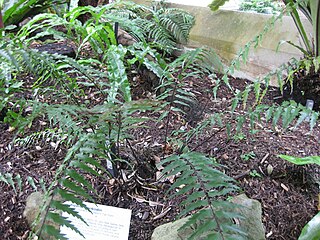
Asplenium polyodon, commonly known as sickle spleenwort, is a species of fern in the family Aspleniaceae. The distribution of A. polyodon includes parts of the countries of Australia and New Zealand. A specific locale of occurrence is in forested areas of Westland, New Zealand, where associate understory species include crown fern.

Metrosideros perforata, also known as white rata, climbing rata, akatea or Akatorotoro, is one of twelve Metrosideros species endemic to New Zealand. It is one of three white flowering rātā vines.

Coprosma spathulata is a shrub that is native to New Zealand. An example occurrence of this species is within the Hamilton Ecological District in the North Island within a forest dominated by Nothofagus and rimu, where understory associates include Blechnum discolor and Doodia media.

Dicranoloma is a genus of mosses in the family Dicranaceae. The Dicranoloma mosses are distributed in the Southern Hemisphere, while the Dicranum mosses are found in the Northern Hemisphere. Species within this genus are dioicous. Another genus in this family is Campylopus. Example occurrences of the genus Dicranoloma is in the form of mats on beech/podocarp forest floors of New Zealand's northern South Island. Dicranoloma dicarpum has a wide distribution in both hemispheres.
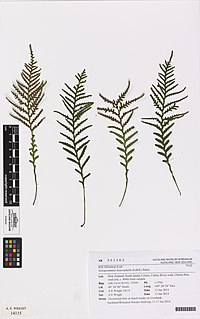
Notogrammitis heterophylla is a species of fern within the family polypodiaceae ferns. The species is found in New Zealand, Tasmania and Victoria, Australia. This plant is epiphytic In New Zealand's Westland N. heterophylla occurs in association with other epiphytes such as Asplenium polyodon and Trichomanes reniforme.
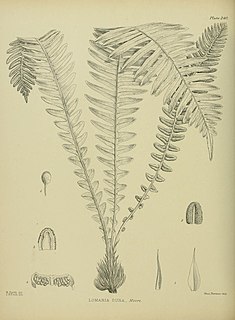
Austroblechnum durum, synonym Blechnum durum, is a species of fern in the family Blechnaceae. The fern is endemic to New Zealand.

Pseudopanax colensoi is a species of evergreen plant. This species is native to New Zealand. An example occurrence in central Westland podocarp/broadleaf forests includes flora associates such as Cyathea smithii and Dicksonia squarrosa, Rumohra adiantiformis, Ascarina lucida, Pseudowintera colorata and Blechnum discolor. The maximum height of this plant is 5 meters and it is the preferred food of possums.
Pseudopanax edgerleyi is a species of plant which is native to New Zealand. An example occurrence in Westland District Podocarp/broadleaf forests includes flora associates such as Cyathea smithii, Dicksonia squarrosa and Blechnum discolor.


















